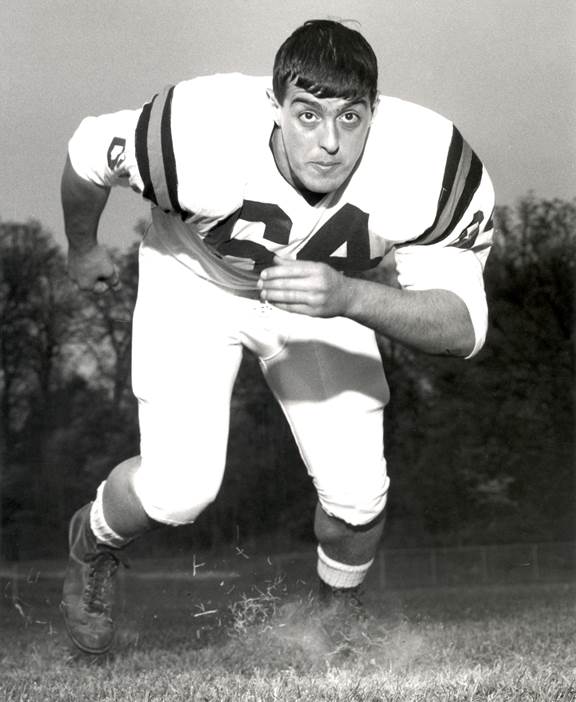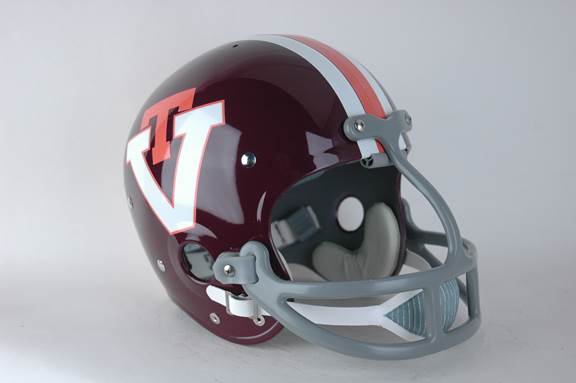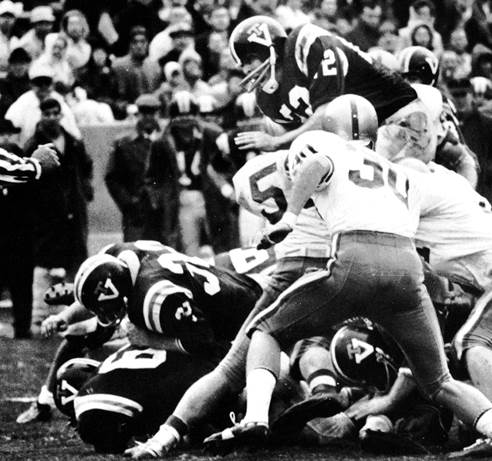

RICHARD MOLLO, A REFLECTION OF JERRY CLAIBORNE'S VA TECH HOKIES
HELMET HUT NEWS/REFLECTIONS May 1 2016:
RICHARD MOLLO, A REFLECTION OF JERRY CLAIBORNE'S VA TECH HOKIES
By Dr. Ken
A game worn 1966
Virginia Tech helmet
A charter member of the
Southern Conference that was
founded in 1921, Virginia
Polytechnic University
underwent significant growth
and a number of name changes
after its founding as an
agricultural and mechanical
college. Football was an
integral part of the student
body experience with most
players recruited locally or
from the surrounding
southern states. Entering
the 1960’s, most football
playing schools located in
rural areas like Virginia
Tech, discovered that it
would be difficult to
maintain a high standard
without recruiting out of
their home state and
immediate region, and they
thus expanded their reach.
When Bear Bryant’s former
Alabama football teammate
and Kentucky assistant Frank
Moseley who had served as
Virginia Tech’s head coach
and athletic director from
1951 through the ’60 season
decided to put his full
efforts into his
administrative job, it was
Bryant who recommended his
current defensive coach
Jerry Claiborne for Tech’s
top spot. A former Bryant
coached player at Kentucky,
Claiborne was a solid end
and safety and became a
brilliant coach and
persuasive recruiter. He
immediately understood the
need to enlarge his
recruiting area for the
quick, disciplined, and
hard-nosed athletes needed
to run his Bama type of
system. He established
connections in New Jersey
and New York and brought
down players who proved to
be successful as they bought
into his demanding program.
Among these was Richard
“Bop” Mollo of Long Island’s
Lawrence High School.
Fortunate to attend a high
school with a tremendous
winning tradition and one of
the early strength training
programs, Mollo played with
a number of athletes that
later made their own mark in
collegiate football,
including Purdue’s Sal
Ciampi. Best friends and
training partners, Mollo and
Ciampi had the advantage of
being the center of a
lifting group that called
the Mollo garage
headquarters. Richard’s
father, “Big John” Mollo was
in fact, exceptionally big
and strong, a former
Lawrence football legend
whose employment in the
school district allowed him
to keep an eye on many of
the boys he believed had
potential, and the
opportunity to continuously
encourage them. With Sal
leading the way as the
Thorpe Award winner,
denoting the best player in
the County, and the Lawrence
championship team that was
nationally ranked for 1961,
Mollo would complete a
successful junior year that
attracted recruiting
attention. Expanding the
northern influence of
Virginia Tech, Claiborne
convinced the 5’9”, 190
pound Mollo to bring his
intense approach to the game
down to Blacksburg after he
captained the ’62 Lawrence
squad.
Short, strong, and
quick, Richard quickly
established himself and
entered his 1964
sophomore season as a
key member of the
defensive line that
played in Claiborne’s
innovative Wide Tackle
Six alignment. Depletion
of the offensive front
however necessitated his
move to tackle and
wearing number 75 he
became a starter on what
was forever referred to
as “The Mighty Mites,”
an offensive line that
averaged just over 190
pounds per man. Taking a
redshirt year in ’65,
Mollo’s
low-to-the-ground
leverage and strength
were again targeted for
the defensive line where
he spent most of spring
ball but his blocking
prowess was needed on
attack. Once again a
starter in ’66 at his
customary right tackle
spot, he switched to
number 64 but his season
was cut short by a knee
injury suffered against
Kentucky at the season’s
mid-point. Missing the
team’s Liberty Bowl game
against Miami, he
battled back via a
concerted strength
training and
conditioning program to
complete his collegiate
career as a starter at
right offensive tackle
for the 7-3 1967
contingent.
Richard Mollo went on to
become an exceptionally
successful coach at his
high school alma mater,
with teams that very
much mirrored those he
played on at Virginia
Tech. They were known
for their high levels of
strength and
conditioning and he sent
many of his students on
to play college
football. He remained a
positive force in the
community during
incidents of racial
tension and violence,
and continues in his
role as a mentor. He had
the privilege of playing
for Jerry Claiborne,
whose success as a head
coach at Tech, Maryland,
and Kentucky, with an
emphasis on churning out
Academic All Conference
and All Americans,
earned him entry to the
College Football Hall Of
Fame. When Claiborne
first arrived at Va
Tech, the uniform had an
appearance similar to
the one he left behind
at Alabama; a white
shell that displayed a
one-inch center stripe
and identifying numerals
on each side. The Hokies
went to a maroon shell
with white player
numerals on each side
and wore these during
Mollo’s sophomore
season.




When he returned to
action in ’66, Richard
and the squad were
donned in maroon helmets
with an attractive
striping arrangement of
a one-inch orange center
stripe with
three-quarters-of-an-inch
white flanking stripes.
A distinctive decal on
each side that featured
an orange “T” atop a
white “V” that was
outlined in orange
remained a staple of the
Virginia Tech helmet
into the 1980’s and is
still utilized as part
of the modern day array
of multiple helmet
designs displayed by the
Hokie team. The Tech
squad was also one of
the first to adopt the
significant utilization
of what were then, new
and innovative Dungard
face masks.